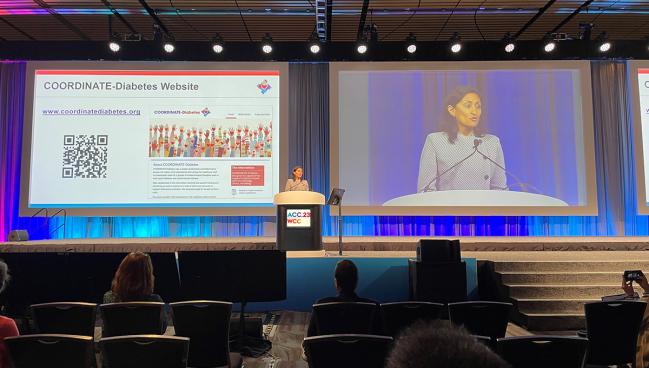Multifaceted Approach to COORDINATE Diabetes Care Improves GDMT
The low-tech, multidisciplinary intervention could have implications for other care pathways and diseases, experts say.

A coordinated, low-tech, multidisciplinary intervention can increase the prescription of evidence-based therapies in patients with type 2 diabetes and atherosclerotic cardiovascular disease (ASCVD), according to the randomized COORDINATE Diabetes trial.
Despite guidance and plenty of evidence guiding clinicians in how best to prescribe medical therapy for their patients with type 2 diabetes and ASCVD, prescription of optimal medical therapy—including high intensity statins, ACE inhibitors or ARBs, and sodium-glucose cotransporter 2 (SGLT2) inhibitors and/or glucagon-like peptide-1 (GLP-1) receptor agonists)—for this population remains inadequate.
“Effectiveness of these therapies is not in question, and yet their use in routine clinical care is astonishingly low,” said Neha J. Pagidipati, MD (Duke Clinical Research Institute, Durham, NC), who presented the data today during the American College of Cardiology/World Congress of Cardiology (ACC/WCC) 2023 meeting. “In the United States, among patients with type 2 diabetes and atherosclerotic cardiovascular disease, only 2.7% of patients are on all three of these groups of therapies and over a third are on none.”
The success of their intervention, even as it shifted to virtual delivery through the COVID-19 pandemic, is such that it needs to be scaled “across cardiology practices in order to improve the quality of care that is being delivered more broadly,” she said. “All it takes is someone with passion and the tenacity of a bulldog—a happy bulldog—to carry this out, and all of the resources are online and they are free.”
All it takes is someone with passion and the tenacity of a bulldog—a happy bulldog—to carry this out. Neha J. Pagidipati
Commenting on the findings during a press briefing, Kristen Campbell, PharmD (Duke University Hospital, Durham, NC), said “the results of this trial are truly valuable, first because of the actual results that we have seen in these patients, but also the future possibilities that it offers. It is so true that we do not do a great job of translating clinical trial outcomes to patient care. And so any methods that we can use to improve those rates are highly needed in clinical practice.”
The multifaceted design of the intervention was “notably simple and that is a particular strength of this trial,” she added. “[The sites] were really given all the information that they needed to set them up for success. And then very importantly, they got regular feedback. . . . Most exciting is the emphasis of interdisciplinary care. I think, working as a team to optimize our patient outcomes is critical and really the way that we will be able to succeed in these endeavors.”
The study was simultaneously published in JAMA.
Intervention Benefits
The intervention included a coordinating center team consisting of a cardiologist, an endocrinologist, and a nurse with implementation experience who communicated with each site to help assess individual barriers to prescribing recommended therapies, develop processes to address those barriers, coordinate care between the different clinicians, provide clinician education, and provide audit and feedback with data.
Pagidipati and colleagues cluster randomized 43 US cardiology clinics treating 1,049 adults (median age 70 years; 32.2% women) with type 2 diabetes and atherosclerotic cardiovascular disease not already taking all three groups of evidence-based therapies to usual care (n = 590) or their intervention (n = 459) between 2019 and 2022. At baseline, about one-third of patients were receiving one of the three recommended classes of medications and just over half were receiving two.
At the last follow-up point, which was at about 12 months for most patients, significantly more patients in the intervention arm had a prescription for all three groups of therapies (primary outcome) compared with those receiving usual care (14.5% vs 37.9%; adjusted OR 4.38; 95% CI 2.49-7.71).
Individually, similar patterns were observed for each group of therapies in the intervention arm from baseline to follow-up, but the magnitude of benefit was greatest for the SGLT2 inhibitors and/or GLP-1 receptor agonists (adjusted OR 3.11; 95% CI 2.08-4.64) compared with high-intensity statins (adjusted OR 1.73; 95% CI 1.06-2.83 and ACE inhibitors or ARBs (adjusted OR 1.82; 95% CI 1.14-2.91).
The intervention was not associated with any changes in ASCVD risk factors, but the trial was not powered to show this nor was risk factor data mandated for collection, Pagidipati said. The composite secondary outcome of all-cause death or hospitalization for MI, stroke, decompensated heart failure, or urgent revascularization was 5% in the intervention group and 6.8% for usual care (adjusted HR 0.79; 95% CI 0.46-1.33).
It is so true that we do not do a great job of translating clinical trial outcomes to patient care. Kristen Campbell
Notably, Pagidipati pointed out, participants reported actually taking their medications at similar rates indicated by prescription data. For high-intensity statins, ACE inhibitors or ARBs, and SGLT inhibitors and/or GLP-1 receptor agonists, 96.3%, 98.0%, and 95.6% of patients, respectively, across both groups who had a prescription at the last follow-up visit also reported taking these medications.
She acknowledged that because the study sites and patients included, the results “may not be representative of the broader US and international population.” Also, because the COVID-19 pandemic mandated that the intervention be delivered entirely remotely, it was “less intensive than we had originally designed,” she noted.
Still, Pagidipati concluded, “evidence-based therapies are underused in clinical practice, and that is not just limited to patients with diabetes and it is not just limited to these therapies, and yet there is little high quality data on how we can improve this. We now have randomized data that this multifaceted intervention is effective in increasing the prescription of evidence-based therapies in adults with type 2 diabetes and atherosclerotic cardiovascular disease. Even though it was multifaceted, it was low tech [and] it was delivered in the midst of a pandemic. It was designed to be scalable.”
To TCTMD, Pagidipati said though she’s happy with the results of the intervention, the improvements in prescribing patterns are not “good enough.” Next, her team plans to look at which patients and clinics benefited from the intervention—and which did not. “Because if it worked at all of the clinics equally, we probably would have seen an even higher benefit,” she said. “And so it is still on us to understand what are the characteristics of the clinics and the patients that would benefit more from this.”
Several themes of barriers emerged across all sites, including dealing with prior authorizations, medications access, familiarity with medications, and using site-specific resources that may not have been previously obvious, according to Pagidipati. For example, “a lot of these sites did have pharmacists that were in their clinic that were resources that they had—they just were not necessarily working on this,” she said. “When we brought a focus on this issue, then they realized, wait, we do have resources at the clinic that can actually help us address this, and so that started streamlining a process for how the pharmacists that they already had could improve access to care for these patients.”
Individual Site Players Key
Campbell agreed that the results could be extrapolated to other aspects of care and across multiple disease states. “That makes it very exciting from a much larger picture,” she said. “Of course, we still have a long way to go. A 38% difference—what they got the patients to—is notable, but that is far from 100%.”
Also commenting on the results during the session, Margo B. Minissian, NP (Cedars-Sinai Medical Center, Los Angeles, CA), said “as members of the cardiology clinical care team, I think everyone in the room understands that the time and expertise that it takes to ensure success for our patients and for them to be overall successful with getting these medications on board can take a lot of time and a lot of money.” She asked: who were the most important participants on these care teams and which clinical models worked best?
“That is that is not just a good question—that's the question,” Pagidipati responded. “Even though the intervention that was tested had a team from the coordinating center, I think far and away, the most important team members for this intervention were at the individual sites.” These at a minimum included a cardiologist, a local diabetes care specialist, and all of the nurse clinicians, advanced practice providers, and pharmacists who were taking care of patients.
“That was an incredibly important part—the idea that we brought the entire team together,” she continued. “What was most critical is that sites that had somebody who was a local champion who said, ‘I am going to take this on and make this an important part of the work that we do.’” More often than not, this person wasn’t a doctor but an advanced practice provider or pharmacist.
And while the cost-effectiveness of this intervention has not yet been assessed, Pagidipati said, “we are in the midst of starting analyses to understand what the costs of the intervention were and what the potential expected benefits are. But I just want to say that the tools that we used were not high tech and they are now all online and they are free.”
Yael L. Maxwell is Senior Medical Journalist for TCTMD and Section Editor of TCTMD's Fellows Forum. She served as the inaugural…
Read Full BioSources
Pagidipati NJ, Nelson AJ, Kaltenbach LA, et al. Coordinated care to optimize cardiovascular preventive therapies in type 2 diabetes: a randomized clinical trial. JAMA. 2023;Epub ahead of print.
Disclosures
- The trial was sponsored by Boehringer Ingelheim Pharmaceuticals and Eli Lilly.
- Pagidipati reported receiving personal fees from Boehringer Ingelheim, Lilly, AstraZeneca, Novartis, Novo Nordisk, Merck, and CRISPR Therapeutics and receiving grants from Amgen, Novartis, Novo Nordisk, and Eggland’s Best.





Comments